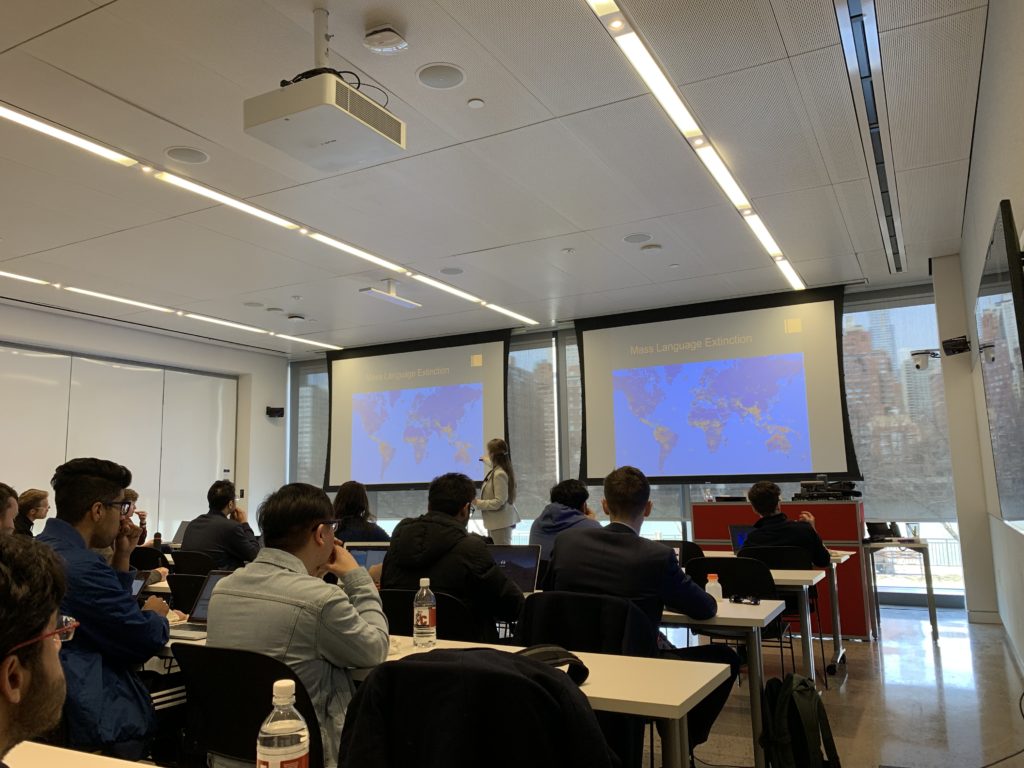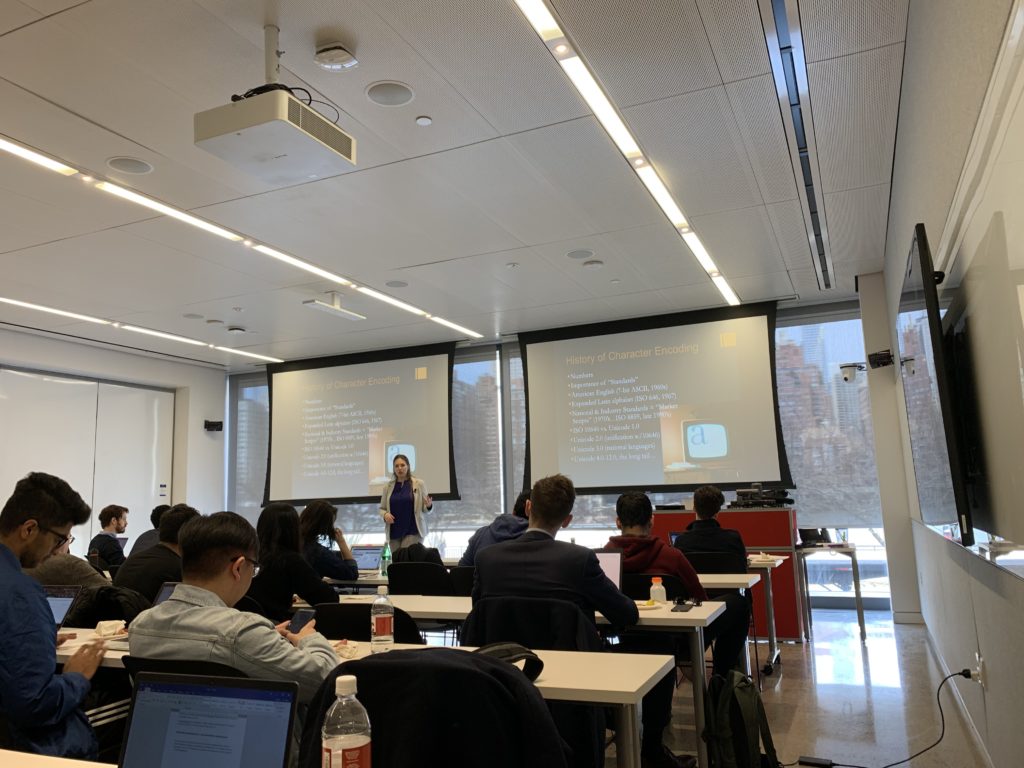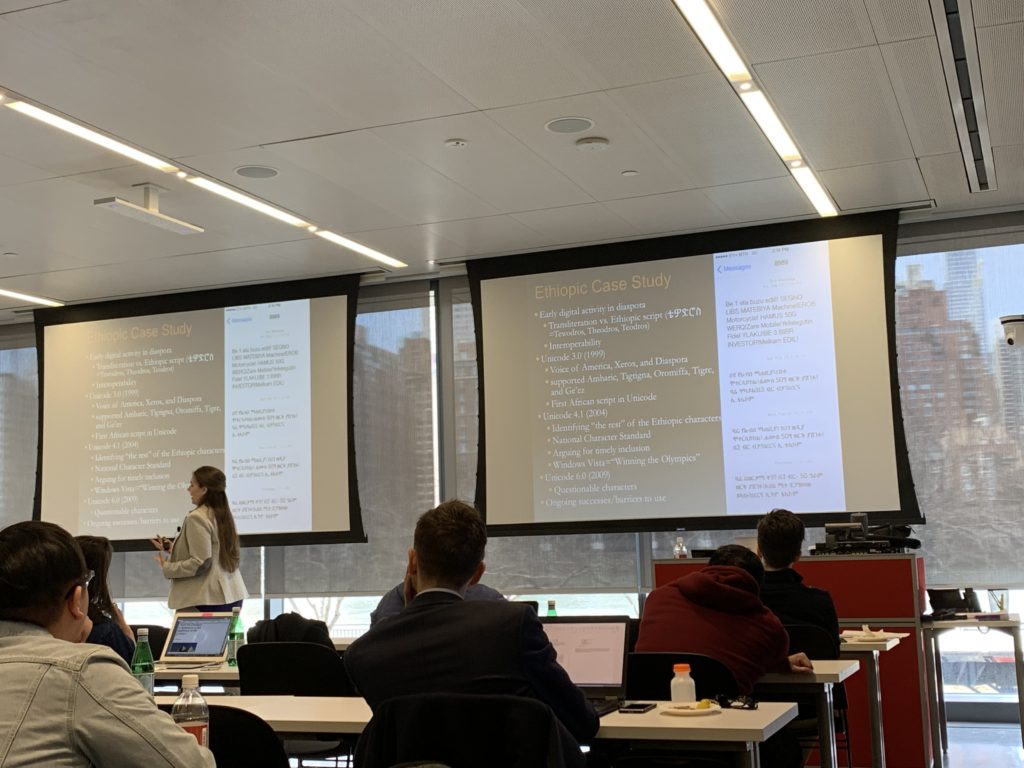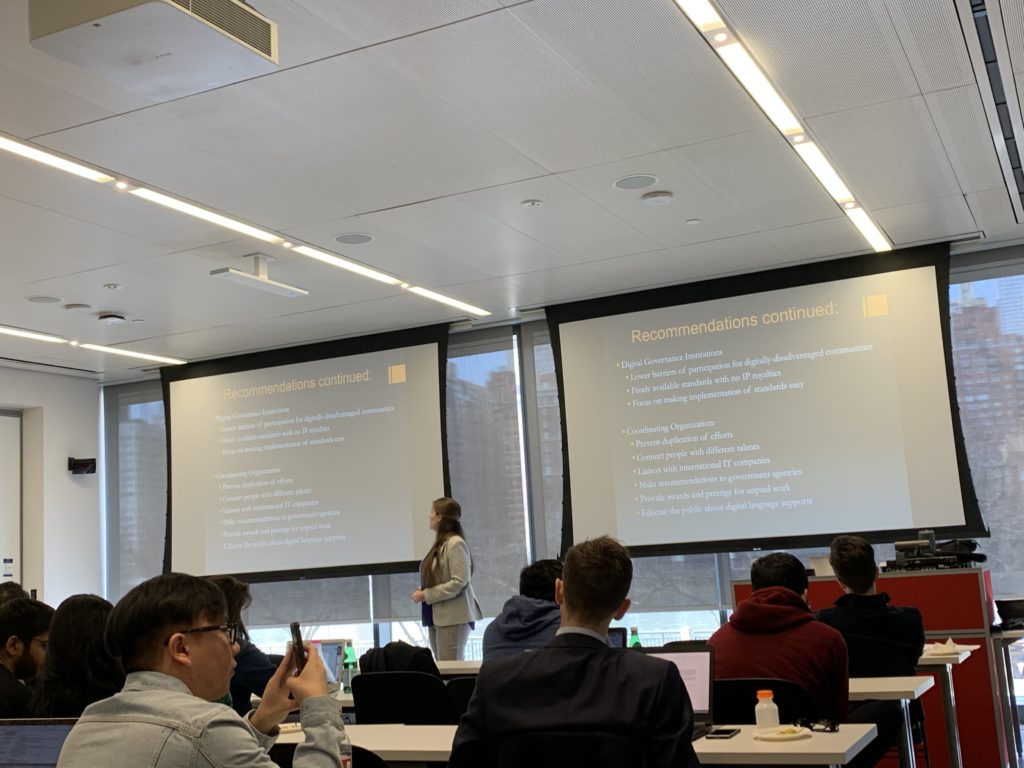Description:
On March 28, I attended the digital life seminar at Cornell Tech on Roosevelt Island. The topic was Precarity and hope for digitally-disadvantaged languages (and their scripts).
What happened at the event:
Isabelle Zaugg, the guest speaker, who was from the Institute for comparative literature and society, Columbia University, gave the audiences a brilliant speech on her topic: mass languages extinction(figure1) and her case study: what can be done to close the digital divide through an instrumental case study of Unicode inclusion and the development of supports for the Ethiopic script and its languages, including Ethiopia’s national language, Amharic.
Language extinction:

Mass languages extinction has been happening worldwide for a long time. In linguistics, language death occurs when a language loses its last native speaker. The extended meaning is when the language is no longer known, including second-language speakers(“language extinction”). The reasons why it happens are colonization, globalization, urbanization, oppression, and digital communication technologies(Zaugg). As we all know, knowledge can be stored in people’s mind and books or databases. However, we can retrieve important information from the books and databases more easily than from people’s mind. If we do not record the knowledge in people’s mind in time, the knowledge will all be gone eventually as the years passed. Language and scripts are the precious wealth our ancestors left us, and we must protect them from disappearing. Nowadays, people get plenty of insights from ancient books or archives to create literary works, artworks, music, even scientific inventions. Here is a very convincing example to show why we should care about the language and scripts extinction: Tu Youyou, the winner of Nobel Prize in Physiology or Medicine in 2015, is a Chinese pharmaceutical chemist and educator. She discovered artemisinin and dihydroartemisinin, used to treat malaria, a significant breakthrough in 20th-century tropical medicine, saving millions of lives around the world. The plant she found the chemical comes from, Artemisia annua L. (sweet wormwood), was used to treat fevers perhaps caused by malaria as early as the third or fourth century CE (Totelin, Laurence). Tu discovered the properties of artemisinin (qinghaosu in Chinese) after reading ancient Chinese texts from The Handbook of Prescriptions for Emergencies that dated back to 341 B.C. listing medicinal herb preparations. If the book did not survive during the thousand years, a much longer time would be needed to find the insights and exact Artemisia to treat malaria.
Case study: Ethiopic language and script

From Zaugg’s speech, I learned that language is a system of communication used by a particular community. A script is written characters. Languages and scripts do not always have a one-to-one relationship(Zaugg). Some scripts are gradually becoming obsolete. The invention of Unicode helps to record and save the scripts. Unicode(figure2) is a computing industry standard for the consistent encoding, representation, and handling of text expressed in most of the world’s writing system(“Unicode”).

In Zaugg’s case study(figure3), mixed methods have been used in the Ethiopic language and script research. The common language of Ethiopia is Amharic, with 345 letters. Its history can be traced back to the 4th century A.D. and it is one of the oldest words in the world today. Because the alphabet contains far more letters than the 26 letters in the Latin alphabet and is complex and difficult to distinguish, it is difficult to be compatible with modern science and technology communication networks. In 2004, with the participation of linguists and scientists from Ethiopia and the United States, and professors from the University of California, researchers reduced the total number of letters from 345 to 210, and then further reduce them into 28 basic alphabetic letters in Unicode. With this development, it has become possible to use Amharic to communicate in text on mobile phones, and Ethiopia’s communications have entered the 21st century rapidly.

Zaugg oversees Unicode and ISO subcommittee working group, interviews with Ethiopic digital pioneers and linguists, and analyzes the non-traditional content of Ethiopic script and languages choices on Facebook, Wikipedia and .et country code top-level web domain. Some recommendations are put forward to save the Ethiopic language and script(figure4): Linguists should collaborate with IT professionals. Governments should optimize the Ethiopic keyboard standard and produce products that implement a free, open-source standard. International IT companies should support language diversity as part of corporate social responsibility(Zaugg).
Reflection:
Technology can mitigate language/script extinction and help to preserve culture heritages. Thanks to technology, scientists can save scripts by converting them to Unicode and spread it through the internet. However, technology is a double-edged sword. While it is helping to preserve languages and scripts, it can harm them in a way. When we were kids, we did not have so many digital devices as the kids have now, such as phones, pads, and laptops. We wrote our research paper on actual paper. We write a lot. Nowadays, most of the keyboards have the character/word suggestion function. A lot of young kids do not need to write by hands and they sometimes do not know how to write actual words because the keyboard suggests them the correct words all the time. In some cases, new immigrants in America cannot communicate with their grandparents smoothly in their native languages. Their grandparents come from the countries which English is not their mother tongue. The young generation cannot inherit the speaking and writing ability of their own languages from their parents or grandparents, therefore, native languages cannot be passed on. The young generation will lose their identity in a way and lose a sense of community and belongingness. In the article Digital Cultural Heritage: Concepts, Projects, and Emerging Constructions of Heritage, Marija Dalbello says: “The significance is related to cultural motion and public endorsement; significance processes are the basis for cultural inventions and collectivist traditions”(1). Only when the public realizes the severity of languages extinction and the significance of cultural heritage, can the technical professionals and the society take actions together to make progress on preventing the language extinction and the loss of cultural heritage.
References:
Zaugg,Isabelle. ‘Precarity and hope for digitally-disadvantaged languages (and their scripts)’. 2019. Lecture.
Wikipedia contributors. “Language death.” Wikipedia, The Free Encyclopedia. Wikipedia, The Free Encyclopedia, 24 Mar. 2019. Web. 31 Mar. 2019.
Totelin, Laurence. “Could Ancient Textbooks Be the Source of the next Medical Breakthrough?” The Conversation, 13 Sept. 2018, theconversation.com/could-ancient-textbooks-be-the-source-of-the-next-medical-breakthrough-48612.
Wikipedia contributors. “Unicode.” Wikipedia, The Free Encyclopedia. Wikipedia, The Free Encyclopedia, 31 Mar. 2019. Web. 31 Mar. 2019.
Dalbello, Marija. (2009). “Digital Cultural Heritage: Concepts,Projects, and Emerging Constructions of Heritage.” Proceedings of the Libraries in the Digital Age (LIDA)conference, 25-30 May, 2009.
Xi Chen INFO 601-02 Assignment 3 Event